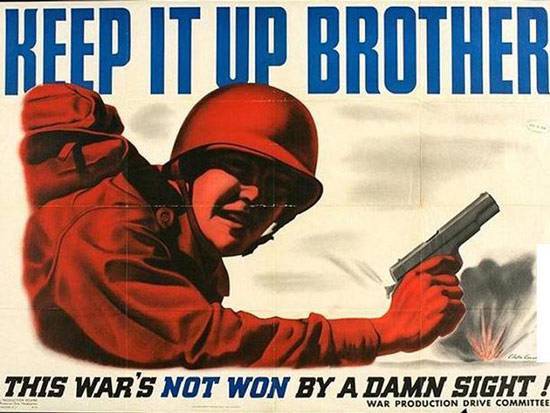David Swanson
Global Research
The National Museum of American History, and a billionaire who has funded a new exhibit there, would like you to know that we’re going to need more wars if we want to have freedom.
Never mind that we seem to lose so many freedoms whenever we have wars. Never mind that so many nations have created more freedoms than we enjoy and done so without wars. In our case, war is the price of freedom. Hence the new exhibit: “The Price of Freedom: Americans at War.”

RICH TRADITION: For generations, Washington has relied on twisted US war propaganda in order to brainwash its youth.
The exhibit opens with these words:
“Americans have gone to war to win their independence, expand their national boundaries, define their freedoms, and defend their interests around the globe.”
Those foolish, foolish Canadians: why, oh, why did they win their independence without a war? Think of all the people they might have killed! The exhibit is surprisingly, if minimally, honest about imperialism, at least in the early wars. The aim of conquering Canada is included, along with bogus excuses, as one of the motivations for the War of 1812.
The most outrageous part of the opening lines of the exhibition, however, may be the second half: “. . . define their freedoms, and defend their interests around the globe.” The exhibition, to the extent that I’ve surveyed it online, provides absolutely no indication of what in the world can be meant by a war being launched in order to “define our freedoms.” And, needless to say, it is the U.S. government, not “Americans,” that imagines it has “interests around the globe” that can and should be “defended” by launching wars.
The exhibit is an extravaganza of lies and deceptions. The U.S. Civil War is presented as “America’s bloodiest conflict.” Really? Because Filipinos don’t bleed? Vietnamese don’t bleed? Iraqis don’t bleed? We should not imagine that our children don’t learn exactly that lesson. The Spanish American War is presented as an effort to “free Cuba,” and so forth. But overwhelmingly the lying is done in this exhibit by omission. Bad past excuses for wars are ignored, the death and destruction is ignored or falsely reduced. Wars that are too recent for many of us to swallow too much B.S. about are quickly passed over.
The exhibit helpfully provides a teacher’s manual (PDF), and its entire coverage of the past 12 years of warmaking (which has involved the killing of some 1.4 million people in Iraq alone) consists of the events of 9/11/2001, beginning with this:
“September 11 was a modern-day tragedy of immense proportions. The devastating attacks by al Qaeda terrorists inside the United States killed some 3,000 people and sparked an American-led war on terrorism. The repercussions of that day will impact domestic and international political decisions for many years to come. At 8:46 a.m. on September 11, 2001, a passenger jet flew into the north tower of the World Trade Center in New York. Fire and rescue crews rushed to the scene. As live TV coverage began, horrified viewers watched as a second plane slammed into the south tower at 9:03 a.m. Thirty-five minutes later a third airliner crashed into the Pentagon. Another jet bound for Washington, D.C., crashed in Pennsylvania after its passengers challenged the hijackers. The nation reeled. But Americans resolved to fight back, inspired by the words of a passenger who helped foil the last attack: ‘Are you guys ready? Let’s roll.’”
If you talk to non-sociopathic teachers, you discover that the sort of “teaching” engaged in by our museums has a horrible impact on students’ understanding.
A new book called Teaching About the Wars is a great place to start. It’s written by teachers who try to present their students with a more complete and honest understanding of war than what’s expected by common text books, many of which are far worse than the museum exhibit described above. These teachers / authors argue that when a teacher pretends to have no point of view, he or she teaches their students moral apathy. Pretending not to care about the world teaches children not to care about the world. Teachers should have a point of view but teach more than one, teach critical thinking and analysis, teach skepticism, and teach respect for the opinions of others.
Students should not be taught, these teachers suggest, to reject all public claims as falsehoods and the truth as absolutely unknowable. Rather, they should be taught to critically evaluate claims and develop informed opinions. Jessica Klonsky writes:
“One of the most successful media-related lessons involved an exercise comparing two media viewpoints. First I showed the first 20 minutes of Control Room, a documentary about Al Jazeera, the international Arabic-language television network headquartered in Doha, Qatar. Students were shocked by the dead bodies and destruction shown on Al Jazeera. For many it was the first time they realized that it wasn’t just soldiers who died in war.”
U.S. soldiers were 0.3% of the dead in the 2003-2011 war on Iraq. These students had been unaware of the other 99.7% of the dead. Learning what war really looks like is perhaps the most important lesson missing from our usual education system.
Another important lesson is who engages in war and why. Bill Bigelow presents a model lesson through which teachers can present students with true situations, but with the names of the nations changed. They can discuss what the nations ought to have done, before learning that one of the nations was their own, and before learning what it actually did. Then they can discuss that reality. Bigelow also begins his teaching about the “war on terrorism” by asking students to work on defining “terrorism” (and not by attacking each other, which is presumably how the National Museum of American History would recommend “defining” such a term).
One teacher ends such a lesson by asking “What difference do you think it would make if students all over the country were having the discussion we’re having today?” Clearly, that question moves students toward becoming potential teachers wanting to share their knowledge to a far greater extent than, say, teaching them the dates of battles and suggesting they try to impress others with their memorization.
Can good teaching compete with the Lockheed Martin-sponsored Air and Space Museum, the U.S. Army’s video games, Argo, Zero Dark 30, the slick lies of the recruiters, the Vietnam Commemoration Project, the flag waving of the television networks, the fascistic pledges of allegiance every morning, and the lack of good alternative life prospects? Sometime, yes. And more often the more it spreads and the better it is done.
One chapter in Teaching About the Wars describes a project that connects students in the United States with students in Western Asia via live video discussions. That experience should be required in any young person’s education. I guarantee you that our government employs drone “pilots” to connect with foreign countries via live video in a more destructive manner who never spoke with foreign children when they were growing up.
David Swanson’s books include War Is A Lie and When the World Outlawed War.
David Swanson’s books include “War Is A Lie.” He blogs at http://davidswanson.org andhttp://warisacrime.org and works for http://rootsaction.org. He hosts Talk Nation Radio. Follow him on Twitter: @davidcnswanson and FaceBook.
READ MORE PROPAGANDA NEWS AT: 21st Century Wire Propaganda Files















